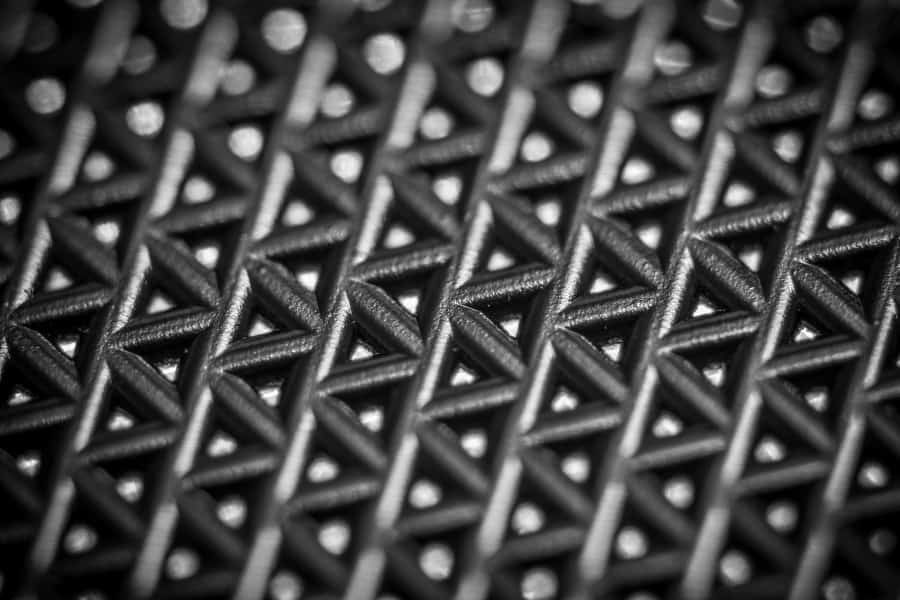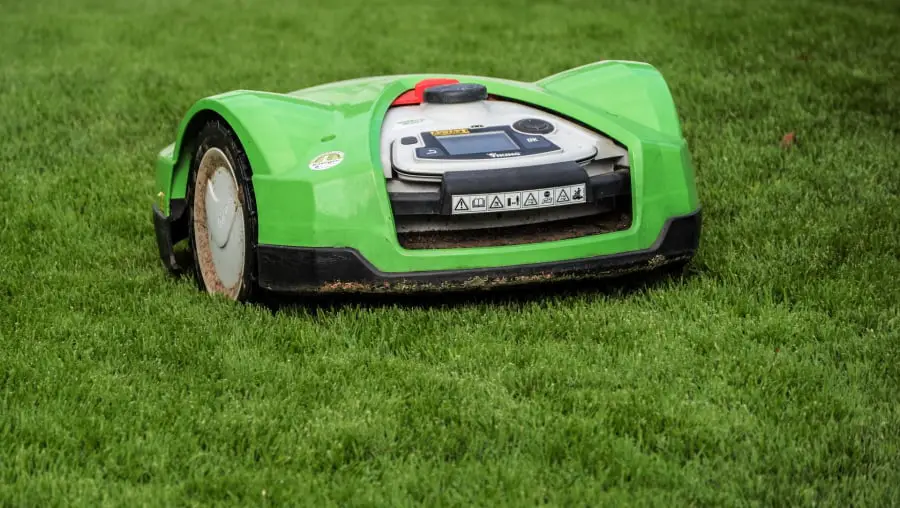Your trusty mower blade never lets you down. It is the ultimate weapon against an unkempt lawn, ready for action at a moment’s notice. But have you ever thought about what mower blades are made of? Or how they’re made?
Lawnmower blades today are made of steel in several different forms. Earlier in the history of lawnmowers, iron was the go to metal for grass cutting. Yet, as time went on technology shifted to high-carbon steel, boron steel, mild steel and even stainless steel mower blades.
This is what the following article seeks to address. We will take a look at the materials (and properties) that make a reliable lawnmower blade. We also take a look at the ways blades are made, strengthened, and sharpened to keep your yard looking spick and span.

Contents
What materials are lawnmower blades made of?
The blade on a mower needs to be tough. Not only does the blade need to be able to cut grass whenever you need it to, but it must be strong enough to survive impact with various sticks, stones, dirt clumps, (gulp) small animals, and so on.
A lawn mower blade needs to be made of a good hard steel that won’t shatter. Yet, it must also be able to be sharpened.
Jerry McMillan, McMillan Lawn Service, 40 Years Experience, Great Grandpa
This is why mower blades have traditionally been made from metal. British inventor Edwin Beard Budding holds the honor of being the man who invented the lawnmower, and his 1830 design featured an iron cutting plate. This was the world’s very first mower blade.
Even before Budding and his creation, grass was kept under control using shears, sickles, and scythes that all featured metal (usually iron) blades. This was the best approach at the time as the alternative would have been to use grazing livestock to keep lawns under control!
Fast forward to today and you will find that metal is still the option of choice when it comes to cutting grass. The major difference is the type(s) of metal we use.
Iron Mower Blades
While iron is very versatile, affordable, and tough, it is also quite vulnerable to rust and corrosion when exposed to the elements over time. Not so great if you’re going to be cutting wet grass all of the time.
It is easily sharpened and a very ‘known’ metal even to the novice. The upkeep can be a chore, but its cost and moldable nature makes it tend to bend rather than break. This makes it ideal for sickles, scythes, and some mowers meant for rough cutting where more expensive blades may make periodic replacement too expensive.
The mixture of iron with other elements can create the lightness of steel and its benefits, but iron still has its uses today.
Steel Mower Blades
Steel, on the other hand, is an alloy (mixture of one metal and other metals/non-metals) of iron, and it has a few distinct advantages over its main component. Steel is stronger, lighter, more durable, and less prone to corrosion than iron, which makes it the far superior choice for tools like lawnmowers.
Steel is made from a combination of iron and carbon. The carbon content may vary but, typically, it’s rarely beyond 2%. This infusion of carbon is what gives the steel its greater strength and longevity.
However, too much carbon makes the steel brittle and prone to shatter.
Steel blades with high carbon content run the risk of shattering if they hit something hard. If this happens while the mower is in use, steel shards may be flung in any direction, which could cause nasty injuries or worse.
As such, the best mower blades need to be tough enough to cut grass neatly, while being absorptive enough to avoid shattering upon impact with hard objects. This delicate balance is something manufacturers have battled to achieve for decades, with some faring better than others.
High Carbon-Steel Mower Blades
While you can still get iron mower blades today, most manufacturers opt for high-carbon steel and boron steel. High-carbon steel is the more common variant when it comes to mower blades as it is more affordable due to mass production.
Typically, steel with a carbon content that is higher than 0.55% is classified as high-carbon steel.
This type of steel is great for cutting grass properly, but it is still prone to wear and tear because of its brittleness. While they are unlikely to shatter, high-carbon steel blades will certainly require regular sharpening and, ultimately, replacement.
High carbon steel is also prone to corrosion over time, which is why such blades are often painted.
Boron Steel Mower Blades
The other popular type is boron steel. Boron is a naturally occurring element that, when combined with carbon steel, produces an alloy closer to the sweet spot mower manufacturers seek. It makes the steel even harder while maintaining a relatively low level of brittleness.
Boron content in this kind of alloy must not exceed 1% otherwise the steel will be made more brittle. Boron steel is the darling of the industry, and a lot of range-topping mowers sport these super strong, super durable blades.
Unfortunately, boron steel is just as vulnerable to corrosion as high-carbon steel…and more expensive.
Mild Steel Mower Blades
Mild steel, also known as low-carbon steel, is another alloy that is commonly used for DIY mower blades. Some companies sell mild steel replacement blades for certain models.
Mild steel is much more affordable than the two other forms discussed above. Unfortunately, that is mainly because it is not as strong, or as durable. This type of blade will require a lot of re-sharpening and replacement. Mild steel is also more prone to shattering, so beware.
Stainless Steel Mower Blades

The other form of steel that is increasingly being used for cutting grass is stainless steel. Stainless steel is made up of a significant proportion of chromium, which makes the alloy impervious to rust, oxidation, or any other forms of corrosion.
Stainless steel is mostly used for the tiny blades on robotic mowers. It is not strong enough to make blades for a full-sized reel, walk-behind, and riding mowers.
How Are Lawnmower Blades Made?
Knowing what a mower blade is made of is only half of the answer to the questions. How they are constructed is important in understanding their durability, effectiveness, and maintenance requirements.
Mower blades are often smithed by the mower manufacturers themselves, or outsourced from specialist metalwork companies. They are forged from a stock metal or alloy and specifically designed for known brands of mowers. Nowadays, steel is the popular choice.
Let’s look at some of the processes that go into how these blades are made and what kind of effort goes into them before they hit the shelves at your local hardware store or center.
Are Lawnmower Blades Heat Treated?
Heat treatment strengthens the blade further, and it forces a well-balanced distribution of firmness, which will make the blade more shatter-resistant and less prone to bending. Heat treatment is often carried out on high-carbon steel to reduce brittleness and extend a blade’s lifespan.
Most of the major lawnmower manufacturers today make use of heat-treated blades. Of course, some lower quality third-party bladesmiths may take shortcuts where this is concerned. When high-carbon steel blades are needed and more durability is desired, heat treating is employed.
During forging, the blade is exposed to high levels of radiative heat and left to air cool. This leads to the realignment and strengthening of the structural bonds holding the alloy together.
The result is a blade with an enhanced capacity to absorb external force.
Are Mower Blades Hardened?
If you are being technical, the answer is ‘Yes…and no’. The real answer though is a bit more straight forward concerning hardening and lawnmower blades.
The very best lawnmower blades are heat-treated and have hardened edges. This allows for the flexibility and durability of the blade as a whole to remain while hardening of the portions that are sharpened helps the blade hold its edge even under heavy and sustained use.
A lot of the time, the top lawnmower manufacturers will make use of blades with hardened edges. Hardening makes the edge stiffer, which improves cutting quality. However, the rest of the blade is not hardened, which allows it to retain its ability to absorb external force.
The Final Touches On What Lawnmower Blades Are Made Of…
To sum up the question in one word, steel is the main metal that mower blades consist of. There are various types of it for different types of jobs. Yet, the common components in most blades is carbon and iron turned into steel.
There are specialty versions that can cost quite a lot and more common ones that will be easily replaceable. All of these factors will come into play when choosing the right steel for the task at hand.
References
https://gardensquared.com/what-kind-of-steel-is-a-lawn-mower-blade/
https://www.gardentoolexpert.com/are-lawnmower-blades-heat-treated/
https://sciencing.com/high-carbon-steel-properties-uses-7596348.html
